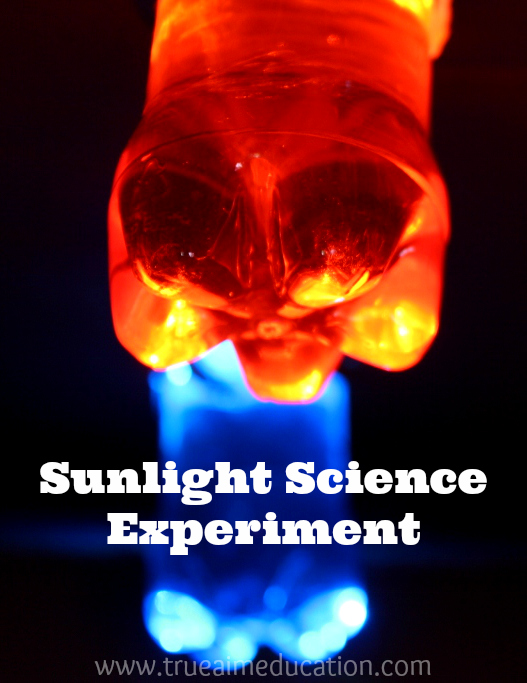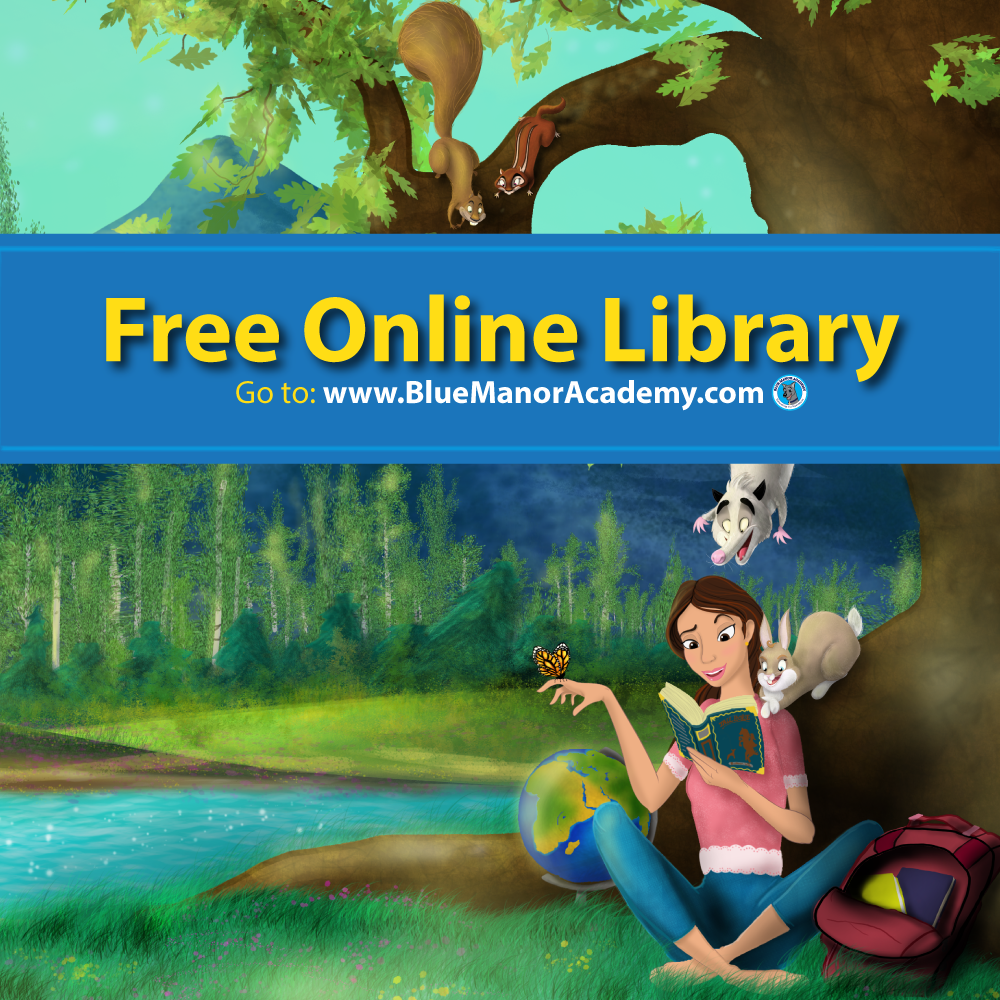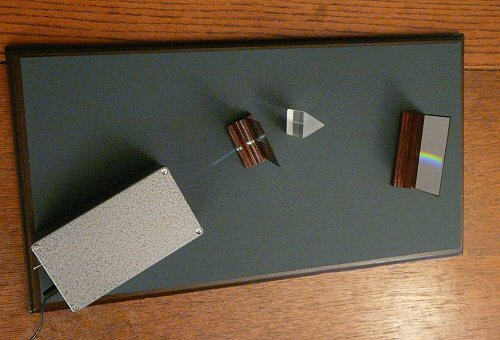Faith, Family and Home Education

Light Box Magic
May 31, 2012 by Janine 63 Comments
Teach kids about light refraction with this fun science experiment for kids.

Also let them watch this video to find out how people use light refraction to light their homes!
How to Make a Sunlight Box:
You’ll need a big box, plastic water bottles, duct tape, scissors, and kids of course! Optional: Paint, Paintbrushes, Food Coloring, Bleach, Foil, Cups that fit over bottles.
Step 1: Let the kids paint the box!
Step 2: fill the bottles with water..
For more fun add food coloring to some of the bottles. I recommend regular sized bottles; around 16oz. Mine were a little small. (If you are going to keep them for a while then you can put bleach in them, but I would skip it.)
Step 3: Trace
Trace the bottom of the bottles on the top of the box and cut holes. Put tinfoil on the top of the box to help the light reflect into the bottles.
Step 4: Make a Viewing Window
Cut a hole in the side of the box to look inside. I recommend cutting a smaller window or just eye holes.
Step 5: Let the experimenting begin!
Push bottles into holes and have the children take turns looking in the viewing window. My daughter Audrey put her hands over the bottles to create a “light show” and I brought some cups out to make it easier.

The Science behind it:
When light from the sun hits a solid object, like the cup, it is absorbed. When light hits the water in the bottle, it bends in all different directions. It bends because the water makes the light slow down. This is called refraction. The water makes the light spread out in the box. I also gave the example of being by the pool. I told the kids we have to wear lots of sunscreen by the pool because the water makes the light spread out and we can burn easily from the light. You can also show the children what the light does when there are just holes in the top of the box and no water bottle.
A Liter of Light needs your help to bring an even better light solution to people around the world! Do the experiment above in your school or home and go to their website to learn how you can help!
Want to give your child a head start?
Check out our Preschool Curriculum!
About Janine
Janine LaTulippe is the Mother of 6 blessings. She believes that an elite education begins in the Home. Her sites www.BlueManorAcademy.com and www.TrueAimEducation.com provide curriculum, free resources, and inspiration for Homeschoolers!

June 1, 2012 at 5:20 am
What a cool experiment! Definitely going to pin this so I remember to do it with my girls. Thanks! Tonya http://www.stringskeysandmelodies.blogspot.com
June 3, 2012 at 5:59 am
Hi Tonya, Thanks for stopping by. I hope your girls have lots of fun with it.
June 1, 2012 at 1:22 pm
This experiment was great, and the kids LOVE it!! Thank you, Melissa
June 3, 2012 at 5:58 am
Thanks Melissa!
June 1, 2012 at 1:54 pm
That is so cool! Thanks for sharing at the Pomp Party! Pinning to our Pomp Party board!
Jill @ Create.Craft.Love.
June 1, 2012 at 7:14 pm
What a cool experiment! I’ll be showing this to my husband this weekend.
Thanks for linking up to our Finished Friday blog party .
June 2, 2012 at 1:58 am
Neat! oh my boys are going to LOVE this!! Adding it to my Summer’s “to do list” 😉 TY!
June 2, 2012 at 3:38 am
I LOVE this! What a cool experiment. I can’t wait to try this with my kids.
June 2, 2012 at 4:05 am
So excited for you to try it. It is also a good idea to keep in mind for prepping 🙂 Thanks for stopping by.
June 2, 2012 at 5:25 am
wow! this is so cool! newest follower. Thanks for stopping by my blog to say hello. it’s always fun to meet another Janine -or- Janiene 🙂 hehehe
Blessings! Janiene
June 2, 2012 at 6:10 am
This is really cool. I couldn’t tell what was going on initially, so it was fun to see it all come together.
June 3, 2012 at 5:57 am
I didn’t know if it would work at first, but it was really awesome. I spent a lot of time looking in it too.
June 2, 2012 at 9:49 pm
This is awesome! I am starting homeschooling this fall so I saved this to my favorites for future reference.
So glad you like it. I wish you the best in your homeschooling adventure!
June 3, 2012 at 8:50 am
These look like a lot of fun! My daughter really loves exploring light, so I’ll have to give this a try. Thanks for stopping by Homeschool Mo! Following back, but by RSS feed since Google Friend Connect is so weird these days.
June 4, 2012 at 11:32 pm
Thanks for taking a look and following. I hope your daughter likes it as much as my girls did.
June 3, 2012 at 6:59 pm
How fun ! My boys love experimenting with light, and I can see this being a big hit. Thanks for sharing.
June 4, 2012 at 7:31 am
This is so fun. I’m always looking for fun ideas and experiments to do with my three boys. I can tell they’ll really like this one.
June 4, 2012 at 2:05 pm
I love this idea!! I am going to pin this on my Pinterest board….thanks so much for linking up to A Marvelous Mess!!
June 5, 2012 at 2:03 am
Hi Janine, just stopping by to say how delightful your blog is. Thanks so much for sharing. I have recently found your blog and am now following you, and will visit often. Please stop by my blog and perhaps you would like to follow me also. Have a wonderful day. Hugs, Chris http://chelencarter-retiredandlovingit.blogspot.ca/
June 5, 2012 at 3:29 am
I want to try this!!!! The kids can even play with me too!!! Thanks for such an amazing post!
June 5, 2012 at 4:22 am
What a fantastic idea…can’t wait to try this with my twins! Thanks so much for sharing with the Weekly Kid’s Co-Op…i’m pinning it to our board this week!
June 5, 2012 at 3:29 pm
Thanks! I always love the Co-Op. So many creative people.
June 5, 2012 at 5:54 am
Hey there! Love your blog! I found you via the MMM blog hop and just added myself to your followers! Also I wanted to invite you to come enter a fabulous Steve Madden giveaway I’m having right now!! Hope to see you there! And thanks so much lady! Emily
http://emilymmeyers.blogspot.com/2012/06/steve-madden-giveaway.html
June 5, 2012 at 8:38 pm
Thanks Emily. I will check it out.
June 5, 2012 at 4:43 pm
This sounds like so much fun!!! Thank you for sharing it, I pinned it to my Pinterest to help me to remember!
June 12, 2012 at 3:24 am
Thanks Kristi, it was a lot of fun. I couldn’t stop looking in the box. The kids had to ask for a turn.lol
June 5, 2012 at 5:21 pm
Oh this looks like such a fun activity! Thanks for sharing it!!
I would love it if you would share this post on the Back To School Monday Homeschooling Link-Up! I really think my readers will enjoy it!
http://susangodfrey.com/category/homeschool/back-to-school-monday/
Blessings! Susan Godfrey Finding Beauty – http://www.susangodfrey.com
June 5, 2012 at 8:36 pm
I would love to share this with your readers. Thanks for letting me know about the link-up. I will do it next monday thanks!
June 6, 2012 at 11:42 am
What a cool science lesson! I love the way the light bounces on the walls! Thanks for sharing at tip toe thru tuesday! Kim
June 6, 2012 at 12:28 pm
I can’t wait to try this experiment!
June 7, 2012 at 1:22 pm
This is so cool! What a fun idea! Thanks for sharing!
June 8, 2012 at 4:33 am
What a fun project for kids.. Love it.. I’m pinning it. Thanks for linking up at friday fun party
June 8, 2012 at 4:29 pm
I’ve never seen this before. Good I can now use my left over boxes from moving for my daughters. It’s a very cool idea. I have to add too that your pictures are great!
June 8, 2012 at 7:55 pm
You’re being featured on Saturday Show & Tell this week! I’d love to invite you to share this on the Summer Activities for Toddlers Collection Summer Link Up Collection! http://www.cheeriosandlattes.com/summer-activities-for-toddlers/
Thanks for sharing last week; hope to see you again this week! Mackenzie 🙂 http://www.cheeriosandlattes.com
June 8, 2012 at 10:34 pm
Thanks Mackenzie. I will do that!
June 11, 2012 at 6:14 pm
What a fascinating experiment! I loved that video too. How amazing, using natural, essentially free items to solve a problem! Thanks for sharing with us at Trivium Tuesdays!
June 12, 2012 at 3:28 am
Hi Amy, I’m glad you liked it. The kids really liked watching the video and seeing people using what they had created. It also help start conversations about being thankful to God for what we have because other people can’t even afford to light their homes.
June 12, 2012 at 3:46 pm
I just loved this idea so much that I had to feature it as my spotlighted project of the week! Swing by and grab a button when you get a chance! Kim tiarasandbowties.blogspot.com Tip Toe Thru Tuesday linky
June 12, 2012 at 8:17 pm
Thanks Kimberly. I will!
June 12, 2012 at 5:18 pm
I LOVE this idea!! I’m going to feature it on my PreschoolPowolPackets Facebook page–thanks so much for sharing it at Teach Me Tuesday!!
Thank you Carla. I’m glad you liked it.
June 26, 2012 at 3:01 am
What a fun interactive experiment. This is the kind of project your kids don’t even realize they are actually learning something because they are having so much fun doing it!
June 30, 2012 at 8:58 am
OMG!! This is a very beautiful experiment and I know that the kids had so much fun doing this. Thanks for sharing and thanks for stopping by my blog. I look forward being part of your blog..
July 12, 2012 at 6:35 am
Thank you for this! My son is a science nerd and loves doing experiments. I’m pinning this for future reference (it’s winter here at the moment and not too sunny – this will be great over the summer holidays!) Thanks for visiting Maker*land and following along – I’m returning the favour and will be sure to visit often. Cheers! 🙂
July 15, 2012 at 11:28 am
That is a brilliant experiment! I shall be having a go at this one.
Thanks for sharing on Family Frolics!
December 3, 2012 at 8:09 pm
Very cool and so simple to do with materials on hand. Thanks for the great idea!
May 8, 2013 at 10:20 pm
How fun! And the results were beautiful too! Next time I get my hands on a big box we might have to try this out!
June 25, 2013 at 8:41 am
That’s a pretty cool experiment!
June 26, 2013 at 7:11 am
This is a super fun idea!!
June 27, 2013 at 5:20 am
That’s a cool activity!
[…] 15, 2013 by Janine LaTulippe Leave a […]
[…] Light Box Magic Your kids will learn about light refraction with this low cost science experiment. […]
[…] about sun light and light refraction, and I am sure kids will be amazed by what they will see in this cool experiment. In addition, we […]
[…] Light Box Magic | True Aim Education […]
[…] Light Box Magic […]
[…] Build a light box and enjoy the play of sun and shadows following instructions from True Aim. […]
[…] LightBox Magic | True Aim Education […]
[…] a fun project ideal for preschoolers (and older kids can lend a helping hand). Demonstrate how sunlight reflects and refracts light with a few simple things you’ll find around the house: water-filled plastic bottles, food […]
[…] Light Box Magic ~ True Aim Education […]
[…] Cardboard Box Light STEM by True Aim Education […]
[…] Learn more: True Aim Education […]
[…] Use this activity to create a conversation about how the sun and water work together.Learn more: True Aim The Blue Manor BlogThis engaging video is well-paced and informative at an age-appropriate level for pre-K students. […]
Leave a Reply Cancel reply
Your email address will not be published. Required fields are marked *

- Privacy Policy

Light Box Activities for Learning and Playing

That is the coolest thing Heather! I bet the kids had a lot of fun playing with it and exploring. Our fifth-grade is doing light and sound now. I will have to mention this activity to go with it.

Thanks, Carla! I do love what light boxes/tables do for even the simplest activities. I hope your fifth-graders are able to give it a try!
WE have a light table at our school. The students love it. It is also great to use with x-rays with your pretend play doctor or vet. I have also printed story telling pieces on milk filters to play with on the light table.
Newtons Experiments - light and prisms


IMAGES
VIDEO